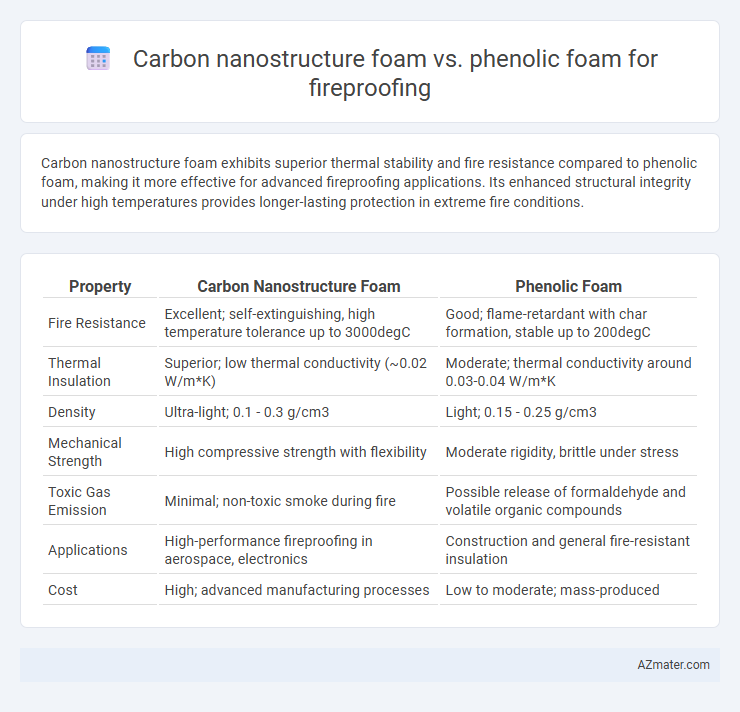Carbon nanostructure foam exhibits superior thermal stability and fire resistance compared to phenolic foam, making it more effective for advanced fireproofing applications. Its enhanced structural integrity under high temperatures provides longer-lasting protection in extreme fire conditions.
Table of Comparison
| Property | Carbon Nanostructure Foam | Phenolic Foam |
|---|---|---|
| Fire Resistance | Excellent; self-extinguishing, high temperature tolerance up to 3000degC | Good; flame-retardant with char formation, stable up to 200degC |
| Thermal Insulation | Superior; low thermal conductivity (~0.02 W/m*K) | Moderate; thermal conductivity around 0.03-0.04 W/m*K |
| Density | Ultra-light; 0.1 - 0.3 g/cm3 | Light; 0.15 - 0.25 g/cm3 |
| Mechanical Strength | High compressive strength with flexibility | Moderate rigidity, brittle under stress |
| Toxic Gas Emission | Minimal; non-toxic smoke during fire | Possible release of formaldehyde and volatile organic compounds |
| Applications | High-performance fireproofing in aerospace, electronics | Construction and general fire-resistant insulation |
| Cost | High; advanced manufacturing processes | Low to moderate; mass-produced |
Introduction to Fireproofing Materials
Carbon nanostructure foam and phenolic foam are prominent fireproofing materials valued for their thermal resistance and structural integrity under high temperatures. Carbon nanostructure foam exhibits superior heat insulation and low thermal conductivity due to its unique nanoscale porous architecture, enhancing flame retardancy and reducing combustible gas release. Phenolic foam, derived from phenol-formaldehyde resin, provides excellent fire resistance with low smoke emission and strong char formation, making it a traditional choice for passive fire protection in construction and industrial applications.
Overview of Carbon Nanostructure Foam
Carbon nanostructure foam exhibits exceptional fireproofing capabilities due to its high thermal stability and low thermal conductivity, outperforming traditional phenolic foam in resisting heat and flame spread. Its porous, lightweight structure enhances insulation efficiency while maintaining mechanical strength under extreme temperatures. This advanced material also offers improved durability and chemical resistance, making it ideal for high-performance fireproofing applications in aerospace, construction, and industrial sectors.
Overview of Phenolic Foam
Phenolic foam is a highly effective fireproofing material known for its low smoke emission, excellent thermal insulation, and inherent flame retardant properties due to its chemical structure. It provides superior fire resistance, charring rather than melting, which limits heat release and prevents toxic gas production during combustion. Compared to carbon nanostructure foam, phenolic foam is more widely used in construction for fireproofing applications due to its cost-effectiveness and regulatory compliance.
Fire Resistance Performance Comparison
Carbon nanostructure foam exhibits superior fire resistance performance compared to phenolic foam, with higher thermal stability and lower flammability due to its robust carbon network and nanostructured morphology. Its ability to maintain structural integrity at temperatures exceeding 1000degC outperforms phenolic foam, which typically degrades and releases combustible gases at lower temperatures around 300-400degC. This enhanced fire resistance makes carbon nanostructure foam a more effective material for fireproofing applications in high-temperature environments.
Thermal Insulation Capabilities
Carbon nanostructure foam offers superior thermal insulation capabilities compared to phenolic foam due to its lower thermal conductivity and enhanced heat resistance, allowing it to maintain structural integrity at higher temperatures. Phenolic foam, while effective in fire retardance and producing low smoke, exhibits higher thermal conductivity, which can limit its insulation efficiency under extreme heat conditions. Advances in carbon nanomaterials enable carbon nanostructure foam to provide more reliable and durable fireproofing solutions in applications requiring exceptional thermal management.
Mechanical Strength and Durability
Carbon nanostructure foam exhibits superior mechanical strength compared to phenolic foam, with enhanced tensile and compressive resistance due to its nanostructured carbon matrix. Its durability under high-temperature conditions surpasses phenolic foam, maintaining structural integrity in fireproofing applications where phenolic foam may degrade. This robustness makes carbon nanostructure foam a preferred choice for long-term fireproofing solutions in industries requiring resilient and enduring materials.
Environmental Impact and Sustainability
Carbon nanostructure foam offers superior fireproofing with lower environmental impact due to its high thermal stability and recyclability, reducing hazardous waste compared to phenolic foam. Phenolic foam, while effective in fire resistance, involves toxic chemicals and generates more non-biodegradable residues, raising concerns about sustainability. The renewable potential and reduced carbon footprint of carbon nanostructure foam make it a more eco-friendly choice for sustainable fireproofing solutions.
Cost Analysis and Market Availability
Carbon nanostructure foam offers superior fireproofing performance but comes at a significantly higher cost due to advanced manufacturing processes and raw material expenses. Phenolic foam remains more cost-effective and widely available in the market, benefiting from established production methods and extensive distribution channels. Market demand trends indicate growing interest in carbon nanostructure foam for high-performance applications despite its premium price, while phenolic foam dominates standard fireproofing requirements due to affordability and accessibility.
Application Scenarios in Building Construction
Carbon nanostructure foam offers superior thermal insulation and fire resistance, making it ideal for high-risk areas such as industrial buildings and critical infrastructure where enhanced fireproofing is essential. Phenolic foam is widely used in residential and commercial buildings due to its cost-effectiveness and adequate fire-retardant properties for standard fire safety requirements. Building construction projects prioritize carbon nanostructure foam in applications demanding extreme fire performance and durability, while phenolic foam serves well in less stringent fireproofing scenarios.
Future Trends in Fireproof Foam Technologies
Carbon nanostructure foam exhibits superior thermal stability and enhanced flame retardancy compared to traditional phenolic foam, making it a promising candidate for next-generation fireproofing applications. Advances in nanotechnology and material science are driving the development of hybrid foam systems that combine carbon nanostructures with phenolic matrices to improve mechanical strength and reduce combustibility. Future trends emphasize scalable manufacturing processes and eco-friendly formulations to meet increasing regulatory demands for sustainable and high-performance fireproof insulation materials.

Infographic: Carbon nanostructure foam vs Phenolic foam for Fireproofing
 azmater.com
azmater.com